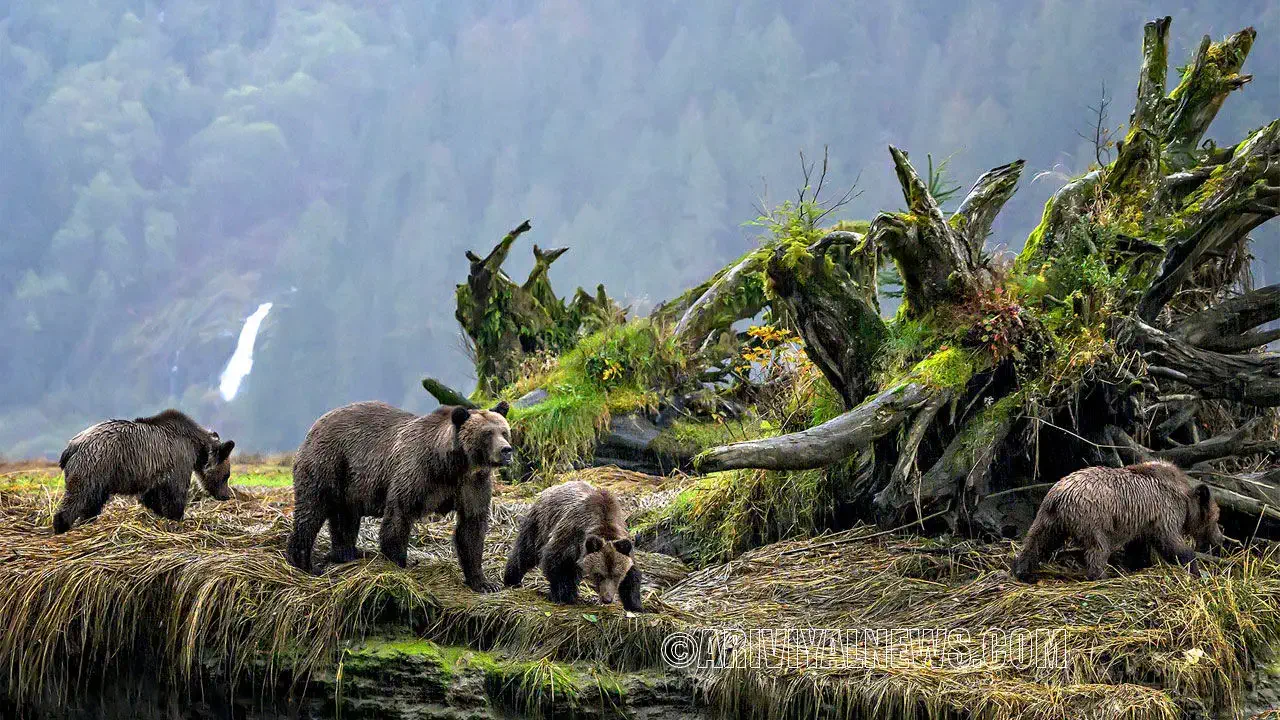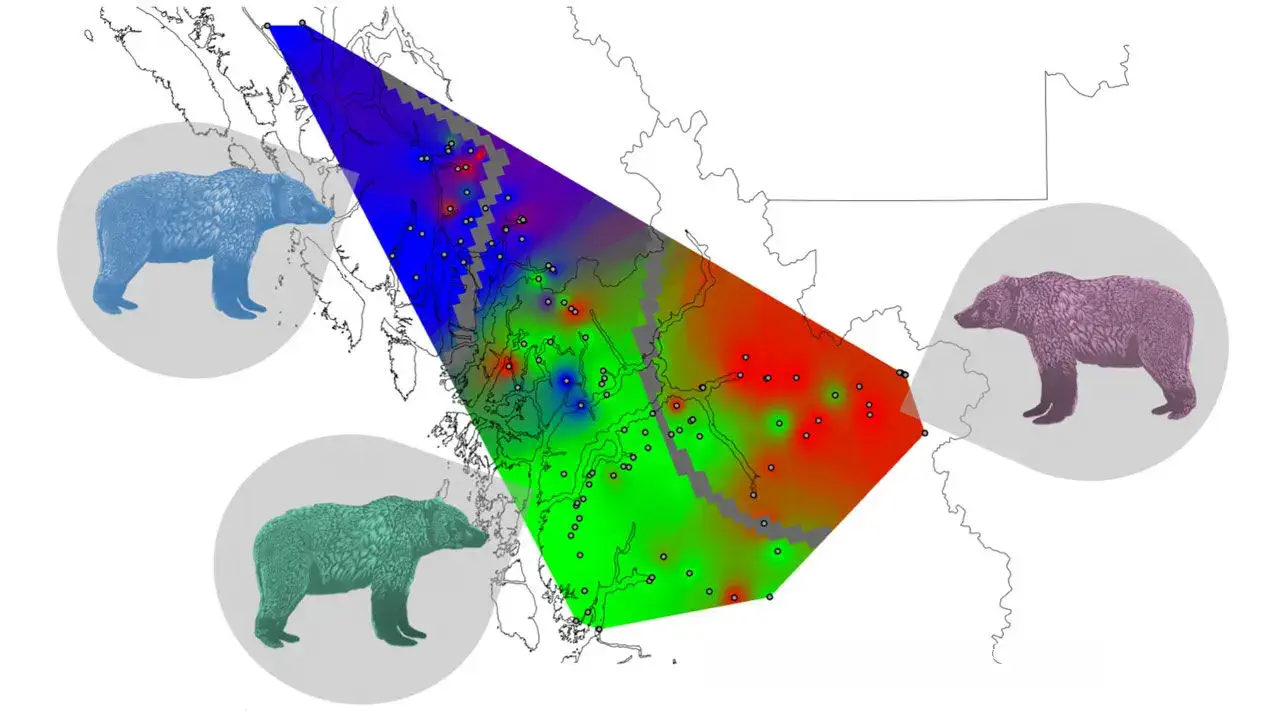
கடலோர பிரிட்டிஷ் கொலம்பியாவின் கரடிகள் மற்றும் பூர்வீக (Tribal language) மனிதர்கள் கண்ணில் காண்பதை விட பொதுவானவை. கனடாவின் மேற்கு கடற்கரையில் அடர்ந்த காடுகள் நிறைந்த பகுதியில் இருவரும் ஆயிரக்கணக்கான ஆண்டுகளாக அருகருகே வாழ்ந்து வருகின்றனர். ஆனால் டிஎன்ஏ தான் தனித்து நிற்கிறது.
ஒரு புதிய பகுப்பாய்வு இங்குள்ள கிரிஸ்லைஸ் மூன்று தனித்துவமான மரபணு குழுக்களை உருவாக்குகிறது, மேலும் இந்த குழுக்கள் இப்பகுதியின் மூன்று பழங்குடி மொழி குடும்பங்களுடன் நெருக்கமாக இணைகின்றன. பிராந்தியத்தில் கலாச்சார மற்றும் உயிரியல் பன்முகத்தன்மை எவ்வாறு பின்னிப் பிணைந்துள்ளது என்பதைக் காட்டும் ஒரு “மனதைக் கவரும்” கண்டுபிடிப்பாகும் என்று ஜெல்ஸி பாப் கூறுகிறார்.
ஆராய்ச்சி முற்றிலும் ஒரு மரபியல் ஆய்வாகத் தொடங்கியது. கிரிஸ்லிஸ் சமீபத்தில் பிரிட்டிஷ் கொலம்பியாவின் கடற்கரையில் உள்ள தீவுகளை காலனித்துவப்படுத்தத் தொடங்கியது, மேலும் விஞ்ஞானிகள் மற்றும் பழங்குடி வனவிலங்கு மேலாளர்கள் இந்த முன்னோடியில்லாத நடவடிக்கையை ஏன் செய்கிறார்கள் என்பதை அறிய விரும்பினர்.
அதிர்ஷ்டவசமாக, 2011 ஆம் ஆண்டில், பிராந்தியத்தின் ஐந்து முதல் நாடுகள் அந்த வகையான கேள்விக்கு சரியாக பதிலளிக்க ஒரு கூட்டு “கரடி பணிக்குழு” அமைத்தது. லாரன் ஹென்சன், ரெயின்கோஸ்ட் கன்சர்வேஷன் ஃபவுண்டேஷனுடன் ஒரு பாதுகாப்பு விஞ்ஞானி, நக்ஸால்க், ஹிலாக், கிட்டஷூ/சீசாய்ஸ், கிட்காத், மற்றும் உகினக்ஸ் நேஷன்களின் பணிக்குழு உறுப்பினர்களுடன் இணைந்து, எந்த நிலப்பரப்பு கிரிஸ்லிஸ் தீவுக்கு ஒத்ததாக இருக்கிறது என்பதைக் கண்டுபிடிக்க. .
பணிக்குழுவில் ஈடுபட்டுள்ள ஆராய்ச்சியாளர்கள் 11 ஆண்டுகளில் சேகரித்த கரடி முடி மாதிரிகளை ஹென்சன் பயன்படுத்தினார். மாதிரிகளைப் பெற, குழு பிரிட்டிஷ் கொலம்பியாவின் தொலைதூரப் பகுதிகளுக்குச் சென்றது-அவற்றில் சில ஹெலிகாப்டர் வழியாக மட்டுமே அணுகக்கூடியவை-மற்றும் இலைகள் மற்றும் குச்சிகளைக் குவித்து, அவற்றை நாய் மீன் எண்ணெய் அல்லது மீன் சார்ந்த குழம்பால் மூடின. இது “உண்மையில் எங்களுக்கு மிகவும் பயங்கரமானது, ஆனால் கரடிகளுக்கு புதிரானது” என்று ஹென்சன் கூறுகிறார்.
ஆராய்ச்சியாளர்கள் இந்த கவர்ச்சியான குவியலை ஒரு முள் கம்பியால் சுற்றி வளைத்தனர், இது கரடிகள் வாசனையை சோதிக்க வந்தபோது பாதிப்பில்லாத ரோமங்கள் மற்றும் அதில் உள்ள டி.என்.ஏ. மொத்தத்தில், இந்த குழு 147 கரடிகளிலிருந்து சுமார் 23,500 சதுர கிலோமீட்டர்களுக்கு மேல் மாதிரிகளைச் சேகரித்தது – இது வெர்மான்ட்டின் அளவு.



ஹென்சனும் அவளுடைய சகாக்களும் மைக்ரோசாட்லைட் டிஎன்ஏ குறிப்பான்களைப் பயன்படுத்தினர் – மற்ற பிரிவுகளுடன் ஒப்பிடும்போது அடிக்கடி மாறும் மரபணுவின் பகுதிகள் – கரடிகள் ஒருவருக்கொருவர் எவ்வாறு தொடர்புடையவை என்பதைத் தீர்மானிக்க. விஞ்ஞானிகள் ஆய்வுப் பகுதியில் வாழும் கரடிகளின் மூன்று தனித்துவமான மரபணு குழுக்களைக் கண்டறிந்தனர், அவர்கள் இந்த மாதம் சுற்றுச்சூழல் மற்றும் சமுதாயத்தில் தெரிவிக்கின்றனர்.
ஆனால் அவர்களைத் தவிர வேறு எந்த வெளிப்படையான உடல் தடைகளையும் அவர்களால் கண்டுபிடிக்க முடியவில்லை. மரபணு குழுக்களுக்கு இடையிலான எல்லைகள் நீர்வழிகள் அல்லது குறிப்பாக கரடுமுரடான அல்லது பனி மூடிய நிலப்பரப்புகளுடன் பொருந்தவில்லை. கரடிகள் மரபணு ரீதியாக வேறுபடுகின்றன, ஏனெனில் அவை பயணிக்க முடியாததால் அல்ல, ஆனால் இப்பகுதி மிகவும் வளம் நிறைந்ததாக இருப்பதால், அவர்களின் தேவைகளைப் பூர்த்தி செய்ய வேண்டிய அவசியமில்லை என்று ஹென்சன் கூறுகிறார்.
இருப்பினும், கரடிகளின் விநியோகத்துடன் ஒரு விஷயம் தொடர்புடையது: பழங்குடி மொழி குடும்பங்கள். “நாங்கள் மொழி வரைபடங்களைப் பார்த்துக்கொண்டிருந்தோம் மற்றும் குறிப்பிடத்தக்க காட்சி ஒற்றுமையைக் கவனித்தோம்” என்று ஹென்சன் கூறுகிறார். ஆராய்ச்சியாளர்கள் அப்பகுதியின் மூன்று மொழி குடும்பங்களுக்கு உள்ளேயும் வெளியேயும் உள்ள கரடிகளின் மரபணு தொடர்புகளை ஆராய்ந்தபோது, ஒரு மொழி குடும்பத்தின் எல்லைக்குள் வாழும் கிரிஸ்லி கரடிகள் அவற்றுக்கு வெளியே வாழும் கரடிகளை விட ஒருவருக்கொருவர் மிகவும் மரபணு ரீதியாக ஒத்திருப்பதை கண்டறிந்தனர்.
கண்டுபிடிப்புகள் ஆய்வை இணை எழுதிய வுகின்க்ஸ்வ் விஞ்ஞானி ஜென் வால்கஸை ஆச்சரியப்படுத்தவில்லை. ரிவர்ஸ் இன்லெட் என்ற தொலைதூர சமூகத்தில் வளர்ந்த அவள், மனிதர்களுக்கும் கரடிகளுக்கும் இடம், உணவு மற்றும் பிற வளங்களின் அடிப்படையில் ஒரே மாதிரியான தேவைகள் இருப்பதை நேரில் பார்த்தாள். உதாரணமாக, அவர்கள் அதே பகுதிகளில் குடியேறுவது அர்த்தமுள்ளதாக இருக்கும் – உதாரணமாக சால்மன் சப்ளை உள்ளவர்கள். இந்த வரலாற்று உறவு, கரடிகள் மற்றும் மனிதர்களை மனதில் கொண்டு கனடா முக்கிய வளங்களை நிர்வகிக்க வேண்டும் என்று அவர் கூறுகிறார். உதாரணமாக, உகினக்ஸ் Nation, கரடிகளின் தேவைகளை ஆதரிப்பதற்காக அதன் வருடாந்திர சால்மன் அறுவடையை குறைப்பதைக் கவனித்து வருகிறது.
Mind-blowing – Grizzly bear DNA maps onto Indigenous language families!!!



The bears and Indigenous humans of coastal British Columbia have more in common than meets the eye. The two have lived side by side for millennia in this densely forested region on the west coast of Canada. But it’s the DNA that really stands out,
A new analysis has found that the grizzlies here form three distinct genetic groups, and these groups align closely with the region’s three Indigenous language families. It’s a “mind-blowing” finding that shows how cultural and biological diversity in the region are intertwined, says Jesse Popp, an Indigenous environmental scientist at the University of Guelph who was not involved with the work.
The research began purely as a genetics study. Grizzlies had recently begun to colonize islands along the coast of British Columbia, and scientists and Indigenous wildlife managers wanted to know why they were making this unprecedented move.
Luckily, in 2011, the region’s five First Nations set up a collaborative “bear working group” to answer exactly that sort of question. Lauren Henson, a conservation scientist with the Raincoast Conservation Foundation, partnered with working group members from the Nuxalk, Haíɫzaqv, Kitasoo/Xai’xais, Gitga’at, and Wuikinuxv Nations to figure out which mainland grizzlies were most genetically similar to the island ones.
Henson used bear hair samples that researchers involved with the working group had collected over the course of 11 years. To get the samples, the team went to remote areas of British Columbia—some of them only accessible via helicopter—and piled up leaves and sticks, covering them with a concoction of dogfish oil or a fish-based slurry. It “smells really, really terrible to us, but is intriguing to bears,” Henson says.



The researchers then surrounded this tempting pile with a square of barbed wire, which harmlessly snagged tufts of fur—and the DNA it contains—when bears came to check out the smell. In all, the group collected samples from 147 bears over about 23,500 square kilometers—an area roughly the size of Vermont.
Henson and her colleagues then used microsatellite DNA markers—regions of the genome that change frequently compared with other sections—to determine how related the bears were to each other. The scientists found three distinct genetic groups of bears living in the study area, they report this month in Ecology and Society.
But they could not find any obvious physical barriers keeping them apart. The boundaries between genetic groupings didn’t correspond to the location of waterways or especially rugged or snow-covered landscapes. It’s possible, Henson says, that the bears remain genetically distinct not because they can’t travel, but because the region is so resource-rich that they haven’t needed to do so to meet their needs.
One thing did correlate with the bears’ distribution, however: Indigenous language families. “We were looking at language maps and noticed the striking visual similarity,” Henson says. When the researchers analyzed the genetic interrelatedness of bears both within and outside the area’s three language families, they found that grizzly bears living within a language family’s boundaries were much more genetically similar to one another than to bears living outside them.
The findings don’t surprise Jenn Walkus, a Wuikinuxv scientist who co-authored the study. Growing up in a remote community called Rivers Inlet, she saw firsthand that humans and bears have a lot of the same needs in terms of space, food, and other resources. It would make sense, she says, for them to settle in the same areas—ones with a steady supply of salmon, for instance. This historic interrelatedness means Canada should manage key resources with both bears and people in mind, she says. The Wuikinuxv Nation, for example, is looking into reducing its annual salmon harvest to support the bears’ needs, she notes.



